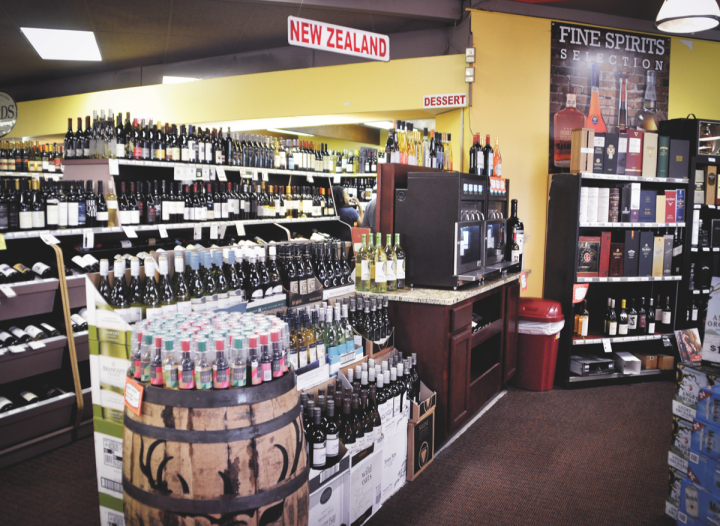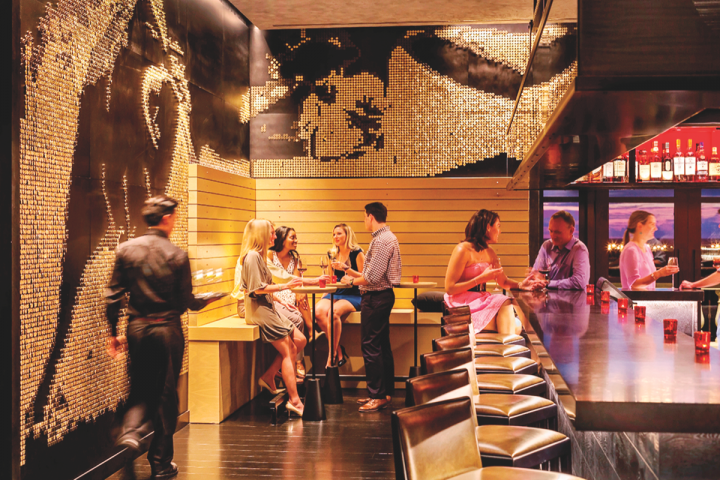
New Zealand wowed its wine audience again last year in the United States, as volumes continued expanding far faster than the overall import category. Over the past several years, the country’s growth has been at double-digit rates. “I thought New Zealand Sauvignon Blanc would level out in 2014,” says Gary Clayton, vice president and director of marketing at Pasternak Wine Imports. The company’s New Zealand portfolio includes Dashwood and Goldwater. “It’s actually advanced at a faster clip in the first quarter of 2015 than all of last year,” Clayton adds. “New Zealand Sauvignon Blanc is connecting in terms of style, quality and image.”
Jan Petrow, senior vice president at Vineyard Brands—marketer of New Zealand wines Mohua and Peregrine—is also surprised by the segment’s ongoing popularity. “The 2014 crop was significantly bigger than in 2013, and nobody seems to be worried about sitting on a glut,” she says. “New Zealand is here to stay in a big way.”
Bottled table wine shipments from New Zealand advanced 16 percent to 3.63 million cases in 2014, while overall New Zealand table wine shipments (including bulk) jumped 19.3 percent to 5.67 million cases, according to Impact Databank. The volume of leading New Zealand wine brands has nearly doubled since 2010. The top 15 brands combined for an 18.5-percent gain to 3.25 million cases in 2014, compared to 1.68 million cases in 2010.

Target Price
While volume continues to expand, opinions are mixed about the health of the value side of the equation. New Zealand wines have largely avoided the low-price route taken by some Argentine Malbecs and Australian wines over the past two decades. For the most part, New Zealand wines have eschewed the under-$10 price point, instead focusing on a “sweet spot” of about $10 to $15 a 750-ml. bottle.
“New Zealand continues to command a price premium versus other wines in the category, with an average shelf price just above $11.50,” says Julie Rossman, global marketing director for Constellation Brands—importer of New Zealand wines Kim Crawford and Nobilo. “Consumers clearly recognize the quality of the wines that New Zealand is producing, as well as the value proposition they offer.”
Ariel Boorstin, brand manager for wines at Pernod Ricard USA, says the premium tier ($10 to $14.99 a 750-ml. bottle) in New Zealand wine has been the fastest-growing segment over the last two years, with double-digit dollar increases. Pernod Ricard markets the New Zealand brand Brancott Estate ($12 a 750-ml. bottle), which includes Sauvignon Blanc, Pinot Noir and Pinot Gris offerings. “New Zealand’s growth is projected to continue to be driven by the premium and premium-plus segments, and Sauvignon Blanc specifically remains the clear varietal benchmark for the category,” Boorstin says. “There are also some fantastic Pinot Noirs coming out of New Zealand, and though the segment remains small, it’s experiencing growth as well.”
While New Zealand wines have largely stayed away from the lowest pricing tiers, few have been able to enter the luxury wine ranks. Pasternak’s Clayton says the sweet spot is $10.99 a 750-ml. bottle, which is roughly the average retail price for Dashwood Sauvignon Blanc. Goldwater, Pasternak’s other New Zealand brand, carries a $15.99 price tag. “It’s much harder to sell a Sauvignon Blanc above that $14.99 price point, so our focus has always been on Dashwood,” Clayton says.
Petrow of Vineyard Brands laments what she calls the “commoditization” of New Zealand wines. “The category is doing incredibly well,” she says. “That said, it’s a category that in many ways is commoditized. The big guys make it harder for the smaller guys due to their domination of retail space. On the other hand, they make it easier on-premise because the restaurants are looking for something that’s not in every big box store.”
At Canal’s BottleStop in Marlton, New Jersey, the top-selling New Zealand wines are some of the larger-volume brands in the United States: Brancott Sauvignon Blanc ($11.96 a 750-ml. bottle), Kono Sauvignon Blanc ($9.96) and Mud House Sauvignon Blanc ($10.49). Yet the store’s e-commerce manager Khadija Woods notes a shift. “People are drinking an increasing amount of New Zealand Sauvignon Blanc, but they’re looking for more nuance these days,” she says. “They’re willing to go from a $9.96 Sauvignon Blanc up to a $15.96 brand if they’ve heard about it or if it’s organic or has more nuance than the typical jalapeño and grassy notes.”
In her experience, upward price resistance comes when brands that have had success decide to push a bit too much. “You can’t go from $13 to $16 and expect consumers to be OK with it,” Woods says.
One New Zealand label that’s shown consistent growth at a healthy price is Oyster Bay ($15 to $19 a 750-ml. bottle), which has almost doubled its volume since 2011 and was up nearly 20 percent last year.

One-Note Song?
Roughly 95 percent of bottled New Zealand wine exported to the United States is Sauvignon Blanc, according to Constellation’s Rossman. New Zealand is counting on that varietal for the continued success in the United States. Samantha Collins, director of luxury, education and trade relations at Treasury Wine Estates (TWE), says most growth is coming from Sauvignon Blanc. The company’s Matua brand is among the fastest-growing New Zealand wines.
The current numbers suggest that New Zealand wines have found a niche that will allow them to thrive. While Sauvignon Blanc is widely grown and produced in several global wine regions, New Zealand wines offer something special, says Bill Terlato, CEO of Terlato Wines International. “The benefit for consumers is that the products are distinctive,” he explains. “There’s a richness and complexity that comes from the Sauvignon Blancs of New Zealand that consumers recognize.”
No matter the quality or current consumer acceptance, relying on a single varietal has some marketers concerned about the long-term potential of New Zealand wines in the United States. “I wish it were a little less of a one-trick pony because there is so much more to offer, including Riesling, Pinot Gris and even Cabernet Sauvignon,” Vineyard Brands’ Petrow says. “I hope over time that things will expand, as they should for any wine region.”
The heavy reliance on Sauvignon Blanc means many on-premise venues carry a limited New Zealand selection. The Four Seasons Resort in Orlando, Florida, lists just three New Zealand wines: Wither Hills Sauvignon Blanc ($11 a glass; $50 a 750-ml. bottle), Cloudy Bay Sauvignon Blanc ($85 a bottle) and Loveblock Pinot Noir ($75 a bottle). Sommelier Jill Davis says the wines perform well.
Todd Rocchio, wine director for Denver restaurant Guard and Grace, admits he’s losing enthusiasm for New Zealand wines and has seen the same attitude among his customers. “Five years ago, I had more representation on my list than I do today, and I think that decline is fueled by demand more than anything,” Rocchio says. “There was a time when you wouldn’t want to run a by-the-glass list without New Zealand Sauvignon Blanc, and now I don’t believe that anymore. People’s palates have evolved out of the astringent nature of the wine and its grapefruit and jalapeño notes.” Rocchio currently carries just one New Zealand label—the 2013 Kim Crawford Sauvignon Blanc ($65) —to fill the expectation from his clientele.
Davis of Four Seasons sees plenty of room for opportunity and growth. “Right now, New Zealand has all its eggs in one basket,” she says. “Sauvignon Blanc has already found its place in our palates. I hope consumers expand a bit because they make lovely wines of other varieties, such as Chardonnay, red blends and Pinot Noir.” Still, she gives the country and the varietal credit. “Nobody would be drinking Sauvignon Blanc at all if it weren’t for New Zealand producers over the past 30 years,” she notes.

Expanding The Palate
To the extent that New Zealand wine marketers are pushing varietals other than Sauvignon Blanc, they are typically focusing on Pinot Noir. “There are people bringing Pinot Noirs to the market, but it still represents an extremely small percentage of the business,” Terlato says. Terlato Wines International imports Wairau River and Loveblock, which includes a Pinot Noir ($37).
While interest may currently be small, some marketers see potential. “With the quality and diversity of vineyards in New Zealand, we feel strongly that there is life beyond Sauvignon Blanc,” Collins of TWE says. “My company has taken a strong position in Central Otago and is making some fantastic Pinot Noirs under the Matua and Etude labels from these vineyards.” The Etude AVA series will soon include a Pinot Noir from Bannockburn in Central Otago, beginning with the 2012 vintage.
Rossman says other varietals are thriving, albeit from a small base. “Consumers are exploring and increasingly favoring other varietals, such as Pinot Noir, Chardonnay and Pinot Gris, which New Zealand’s cool climate produces exceptionally well,” she says. “We see significant potential for these varietals from New Zealand, all of which are growing in the double digits.”
Brancott Estate aims to innovate within Sauvignon Blanc. “Given the persistent popularity of New Zealand Sauvignon Blanc and health of the segment, this grape remains our clear emphasis,” Boorstin says. “We’re focusing on delivering new, fresh takes on this varietal like Flight Song, our low-calorie offering.”
Whether from Sauvignon Blanc or another grape variety, marketers are predicting continued growth for New Zealand wines in the United States. “We expect the aggressive growth trajectory to continue, driven by both Sauvignon Blanc and the expansion of New Zealand overall,” Rossman of Constellation says. “This year will be another outstanding quality vintage. The future is bright for New Zealand wines.”